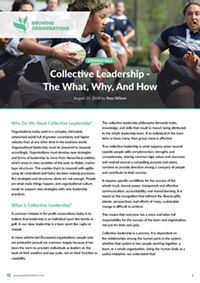Download this blog as a pdf and read it later
Why Do We Need Collective Leadership?
Organisations today exist in a complex, intricately networked world full of greater uncertainty and higher velocity than at any other time in the business world. Organisational leadership must be prepared to respond accordingly. Organisations must develop new strategies and forms of leadership to move from hierarchical entities, which arose in class societies of the past, to the flatter, matrix-type structures of the collective leadership approach. This enables them to respond with agility using de-centralised and faster decision-making processes. But strategies and structures alone are not enough. People are what make things happen, and organisational culture needs to support new strategies with new leadership practices.
What is Collective Leadership?
A common mistake in for-profit corporations today is to believe that leadership is an individual sport like tennis or golf. In our view, leadership is a team sport like rugby or netball.
In many pakeha-led (European) organisations people who are whakahihi (proud) are common, largely because it has been the norm to proclaim individuals as leaders on the basis of their position and pay scale, not on their function or capability.
The collective leadership philosophy demands traits, knowledge, and skills that result in mana1 being attributed to the whole leadership team. If an individual in the team lacks or loses mana, then group mana is affected.
True collective leadership is what happens when several capable people with complementary strengths and competencies, sharing common high values and character, and centred around a compelling purpose and vision, combine to provide direction among a company of people and contribute to their success.
It requires specific conditions for the success of the whole: trust, shared power, transparent and effective communication, accountability, and shared learning. It is based on the recognition that without the diverse gifts, talents, perspectives, and efforts of many, sustainable change is difficult to achieve.
This means that everyone has a voice and takes full responsibility for the success of the team and organisation, not just for their own jobs.
Collective leadership is a process. It is dependent on the relationships among the human parts in the system, whether that system is two people working together, a team, or a whole organisation. Using the human body as a useful metaphor, we understand that:
Management is the efficient and effective functioning of the nervous system controlling all the joints and muscles. (Think robotics, standard operating procedures, code).
Collective Leadership is this brain system collaborating with the pulmonary, endocrine, digestive, and cardio-vascular systems to carry oxygen, hormones & nutrients to all parts of the body to give it LIFE. (Think impact, value, significance).
“Without management there is no action.
Without leadership there is no life.”
In Leadership in the Age of Complexity2, Margaret Wheatley and Debbie Frieze discuss a shift from thinking of a leader as a ‘hero’ to thinking of a leader as a ‘host’. When a leader is the ‘hero’, he or she is expected to have all the answers, solve all the problems, and fix everything for everyone else. The ‘hero’ is dynamic, charismatic, and brilliant. The problem with this mind-set is that the command-and-control model often uses quick solutions that are created by a few in power and often these solutions are not well suited for the complex issues that we face today.
There may be a place for command and control leaders. As Prof. Keith Grint from the University of Warwick explains, when the solution is certain and the crisis is such that urgency prevails, then the coercive, hard, and sometimes physical power of a commander is required. This is sometimes referred to as ‘command and control’. In any other situation, however, it is not required and can be destructive. We see this destruction in religious cults, fringe communes, many charities, and in dictatorships, yet we often don’t acknowledge the danger of these leaders in business.
See: 10 Signs Of A Toxic Leader
Instead of ‘heroes’, Wheatley & Frieze suggest, we need ‘hosts’ as leaders: those who have the skills to promote shared learning, effective group decision making, reflection, visioning and goal setting, and mutual accountability.
“The new currency is no longer ‘intellectual capital’,
but rather ‘social capital’”
Key Differences Between Traditional And Collective Leadership
| Traditional Leadership Approach | Collective Leadership Approach | |
| View of Organisations | Organisations as machines | Organisations as communities |
| Structure | Hierarchical, pyramid | Connected networks, flattened structure |
| Who leads? | Individual managers | A team |
| Who makes decisions? | Top management | Distributed and aligned with areas of responsibility |
| Basis for authority | Positional power – based on title | Personal power – based on knowledge and strengths |
| Communications | Top down, holding on to information, exclusive | Multi-directional, more transparent, inclusive |
| Diversity and Inclusion | Less likely for multiple cultural influences | More likely for multiple cultural influences |
| Processes | Directive – people need to be told what to do | Collective – people are capable and trustworthy to do the right thing |
| Accountability | Buck stops at the top | Shared |
| Beliefs about success | A few individuals have the skill or talent to create success | Success comes from the diverse perspectives and skills of many |
See also Create a Talent-Centric Culture To Unlock The Potential Of Your People
Ten Benefits of Collective Leadership
There are many benefits of the collective leadership approach. Here are some specific benefits you can expect to see when you adopt this approach in your organisation:
1. Break-down of silos
As knowledge sharing and cooperation across the organisation increases.
2. Faster acceptance and implementation of change and innovation
Due to the dissolution of power structures and bureaucracies which often obstruct progress.
3. Better decisions
From diverse perspectives and open feedback, ideas, and direction.
4. Increased self-direction and motivation
With collective leadership, team members are able to generate their own solutions to a problem and, responding to their own internal drivers, interests, desires, and motivations, they are more likely to work towards and sustain change than those who are externally motivated (a.k.a. coerced with ‘carrots and sticks’) from above.
5. Shared responsibility
In the traditional model, the few people at the top often feel an exhausting pressure and a sense of isolation. Those at the bottom of a hierarchy are often under-utilised, with an unfulfilled desire to contribute more. When the responsibility is shared, the work is easier and more fun for everyone involved and the mutual accountability eases the pressure on individuals.
6. Greater utilisation of potential
Collective leadership allows people to contribute fully based on their unique strengths and talents and to develop new knowledge, skills and expertise. People are recognised and trusted for the value they offer and motivated to leverage these for the benefit of the whole team and organisation.
7. Higher levels of commitment and engagement
People have a sense of ownership of the goals: they helped create them, so they are much more invested in seeing them come to life.
8. Superior productivity and performance
People are most motivated and productive when they feel trusted to make decisions and develop solutions, when they feel connected to the purpose of their work, and when they can do things that are challenging and that help them to grow and develop.3
9. Inclusion
Acceptance of multiple voices, and celebration of diversity.
10. Sustainability of results and success
When everything depends on one person the outcomes are limited by that person’s inadequacies and, if that person leaves, the loss of his or her knowledge and skills are difficult to recover. In collective leadership the knowledge, responsibility, and motivation is contributed by all in the group and shared across the group, and the whole is genuinely greater than the sum of the parts.
Developing Collective Leadership
How a team moves towards a collective leadership approach will be different for each organisation, depending on how entrenched the traditional approach is, as reflected in the structure, reporting procedures, decision-making practices and more. Here, we offer some general advice to help you and your teams think about how you might move towards a collective leadership mind-set, and invite you to discuss your particular challenges with one of our advisors.
“Collective leadership becomes possible when the members of a group, motivated by a common purpose, begin to build relationships with each other that are genuinely respectful enough to allow them to co-construct their shared purpose and work.”4
The essence of collective leadership is captured in the image of a human tower. To build the tower, the stronger, more experienced or resourceful individuals of the team place themselves at the bottom, providing a solid foundation for the team they serve (the organisation or community) as we see with servant leadership. In this way, the more vulnerable members, or newer generations, can elevate themselves and rise to higher levels.
Sadly, in many teams, organisations and communities, the opposite happens. The stronger or more resourceful members place themselves at the top. In doing so, they suppress, exploit and take advantage of the weaker, more vulnerable, and less experienced or resourceful members of their team or organisation.
Collective Leadership requires that each team member knows and appreciates his or her own talents, strengths, weaknesses, and history for which they may have earned mana. They then subordinate their individual ambitions to the greater good of the team and contribute out of those personal resources to the team’s effectiveness.
You might say, “If I share the leadership role with others, I’ll have less power and influence!” Correct. You’ll also have peers to question you, force you to sharpen your thinking and justify your opinions. Yes, they’ll have better ideas than yours and they will be better than you are at lots of things. That’s true, and that’s good for everyone. Get used to it and celebrate it.
The team leader gains mana as he or she recognises, welcomes, and fully engages the talents, strengths, weaknesses, and mana of all team members and facilitates collaboration to ensure the greatest benefits of leadership are provided for the whole organisation. Working closely with the whole leadership team, this is what we at Growing Organisations seek to develop to a high level within our client organisations.
As Ken Wilber’s four-quadrant framework suggests (below), effective partnering in collective leadership requires four types of conditions that are complementary and interdependent:
Individual intention: Co-leaders commit to mutual respect, transparency and learning, are willing to surface and challenge their assumptions, and adopt a win-win-win perspective.
Individual behaviour: Partners genuinely listen and give helpful feedback to one another, walk their talk, respect jointly-defined ground rules and honour their commitments.
Culture: The partnership is characterised by shared values and vision, perceived complementary viewpoints and skills, open and frequent communication, search for synergy, and a long-term view.
Structure: The partnership structures and systems include concrete common goals and priorities, behavioural ground rules, agreed upon measures of impact, shared benefits and rewards, clear accountability, and shared responsibility for the whole.5
 Ken Wilbur’s four-quadrant model
Ken Wilbur’s four-quadrant model
Building collective leadership is a cyclical process; it does not happen once and end. Instead, it continues evolving as communities, organisations, and people change. As groups grow and move and as everything around them changes, they continue to learn and relearn about their business and about themselves.
Growing Organisations works with organisations through four stages: 1) building trust, 2) clarifying and communicating strategy (purpose, vision and values), 3) acting together, and 4) deepening, integrating, and sustaining collective leadership. We help build awareness, confidence, and competence at the individual and team levels for effective dialogue, decision-making, co-operation and collaboration.
Notes/Resources:
- Mana – A Maori word meaning something like respect, authority, wisdom, strength and it is attributed to those considered deserving of the honour by those who recognise that person or group’s influence for good within a community.
- Leadership in the Age of Complexity: From Hero to Host, by Margaret Wheatley and Deborah Frieze
- Drive: The Surprising Truth about What Motivates Us, by Daniel Pink
- Collective Leadership Framework klcc.org
- Developing Collective Leadership: Partnering in Multi-stakeholder Contexts, Alain Gauthier
Other Sources
hrmonline.com.au, leadershiplearning.org, kklc.org, Pts.net.au, nonprofitquarterly.org

ABOUT THE AUTHOR
Ross Wilson is an Organisational Performance Consultant and Managing Director of Growing Organisations. For more information about developing collective leadership in your organisation, contact us today.
E: ross.wilson@growingorganisations.com | T: 021 152 8400







